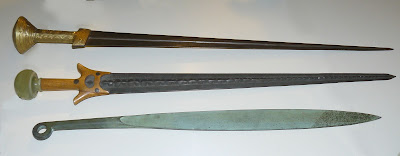For
the weapon of the fortnight, I chose the Makhaira, a sword that was used during
biblical time. When I think of Romans 13 verse 4, I wonder if this was the
sword manufactured to execute criminals and for warfare. I got the information
from Wikipedia.
 |
| Reconstruction of Mycenaean swords, the bottom one being a makhaira-type sword. |
Makhaira (from Greek μάχαιρα
(mákhaira, plural mákhairai), also transliterated machaira
or machaera; a Greek word, related to μάχη (mákhē) "a
battle", μάχεσθαι (mákhesthai) "to fight", from PIE
*magh-) is a term used by modern scholars to describe a type of ancient
bladed weapon, generally a large knife or sword with a single cutting edge.
 |
|
Makhaira sword - modern reproduction. The
slight forward curve of the blade would make this weapon intermediate between a
true makhaira and a kopis.
|
Characteristics:
Homer mentions the makhaira, but as a
domestic knife of no great size. In period texts, μάχαιρα has a variety of
meanings, and can refer to virtually any knife or sword (taking the meaning of
today's Greek μαχαίρι), even a surgeon's scalpel, but in a martial context it
frequently refers to a type of one-edged sword; a sword designed primarily to
cut rather than thrust. Modern scholars distinguish the makhaira from the kopis
(an ancient term of similar meaning) based on whether the blade is forward
curved (kopis), or not (makhaira).
These weapons were of various sizes and
shapes, being regional, and not exclusively Greek. Greek art shows the Lacedaemonian
and Persian armies employing swords with a single cutting edge, but Persian
records show that their primary infantry sword was two edged and straight,
similar to the Greek xiphos (cf. acinaces).
Use:
While Xenophon states that the xiphos was
more conventional among Greek armies of his time, he recommended the makhaira
for cavalry. "I recommend a kopis rather than a xiphos,
because from the height of a horse’s back the cut of a machaira will
serve you better than the thrust of a xiphos." (Xenophon, 12:11). His reasoning concurs with the general practice of arming cavalry with cutting
swords through the ages. Greek art along with Xenophon's further commentary
suggests that the sword he intended for the cavalry was wider than the more
modern sabre; more akin to the falchion or even machete.
The Koine of the New Testament uses the word makhaira
to refer to a sword generically, not making any particular distinction between
native blades and the gladius of the Roman soldier. This ambiguity appears to
have contributed to the apocryphal malchus, a supposedly short curved
sword used by Peter to cut off the ear of a slave named Malchus during the
arrest of Jesus. While such a weapon clearly is a makhaira by ancient
definition, the imprecise nature of the word as used in the New Testament
cannot provide any conclusive answer.
Makhaira entered classical
Latin as machaera, "a sword". In modern Greek, μαχαίρι means
"knife."
 |
| Antique swords, fig. 1-3: Xiphos, fig. 4: Makhaira. |


No comments:
Post a Comment